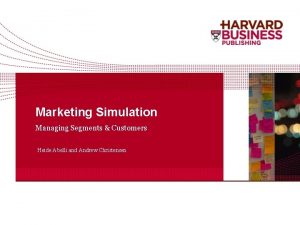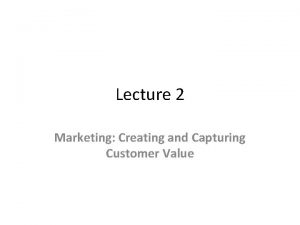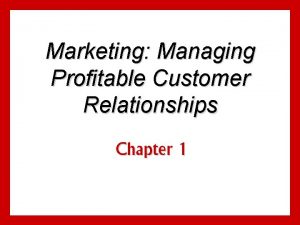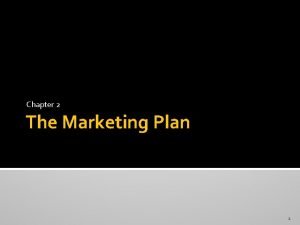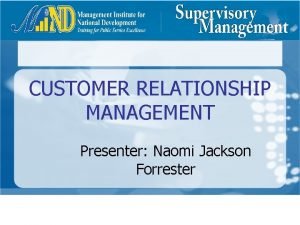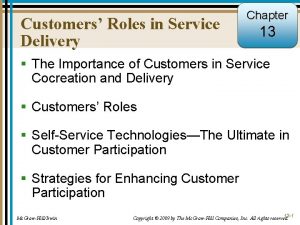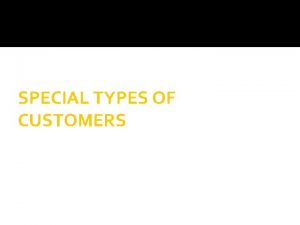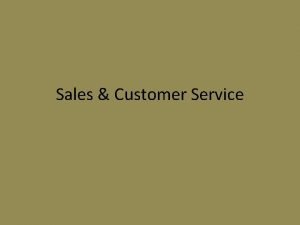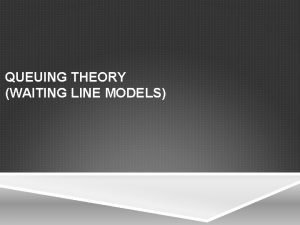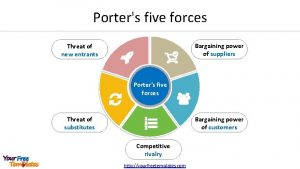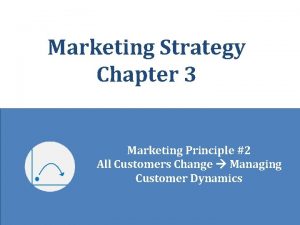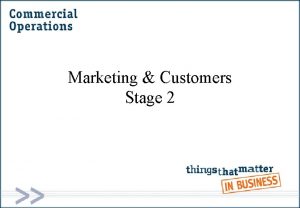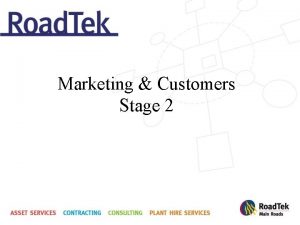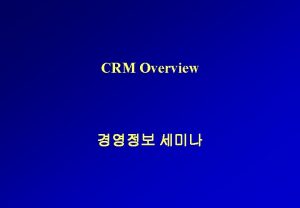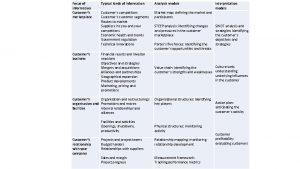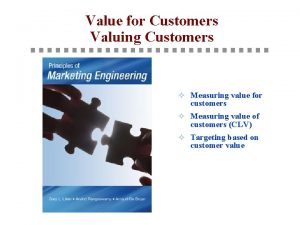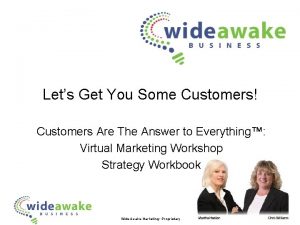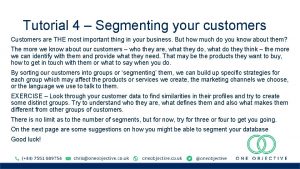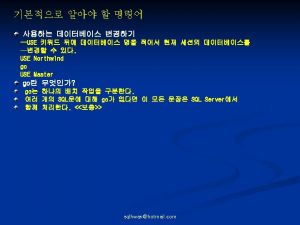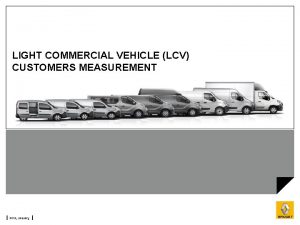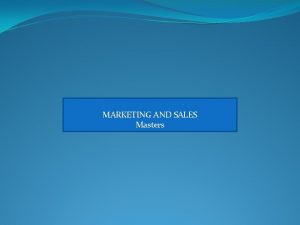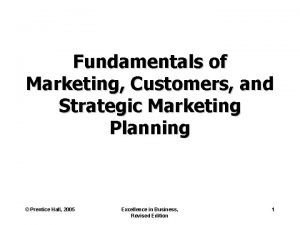Marketing Plan Way to Marketing Plan Customers and























- Slides: 23

Marketing Plan

Way to Marketing Plan

Customers and Customers Needs Distinguishing characteristics of your primary target markets and market segments. Narrow your target markets to a manageable size. Efforts to penetrate target markets that are too broad are often ineffective e. Critical needs f. Extent to which those needs are currently being met g. Demographics h. Geographic location i. Purchase decision-makers and those exercising influence Seasonal/cyclical trends

Service or Product Line a detailed description of your product or service (from your customers' perspective). information related to your product's life cycle. any copyright, patent, and trade secret information that may be relevant research and development activities you are involved in

Market Analysis Industry Description and Outlook Ø Size and Growth Ø Profitability Ø Cost Structure Ø Distribution Systems Ø Trends and developments Ø Key success Factors

Market Analysis Contd. . Identifying Your Target Market Ø Distinguishing characteristics of the major/primary market you are targeting. Ø Size of the primary target market. Ø The extent to which you feel you will be able to gain market share and the reasons why. Ø Your pricing and gross margin targets. Ø Resources for finding information related to your target market. Ø Media you will use to reach your target audience. Ø Purchasing cycle of your potential customers. Ø Trends and potential changes which may impact your primary target market. Ø Key characteristics of your secondary markets

Competitor Analysis

Industry concept of competition Classifications Ø Number of sellers and Degree of differentiation Ø Entry, mobility and exit barriers Ø Cost structure Ø Degree of Globalization

WHO ARE THE COMPETITORS? Ø Against whom do we usually compete? Who are our most intense competitors? Less intense but still serious competitors? Makers of substitute products? Ø Can these competitors be grouped into strategic groups on the basis of their assets, competencies and/or strategies? Ø Who are the potential competitive entrants? What are their barriers to entry? Is there anything that can be done to discourage them?

Strategic Groups Ø Groups of firms that pursue similar competitive strategy ( Communication, price, distribution etc) Ø Have similar characteristics( e. g. aggressiveness) Ø Have similar assets or competencies ( brand associations, logistics, global presence or R & D etc)

Competitor Analysis Why? Competitors actions are influenced by Ø Size, growth and profitability Ø Image and positioning strategy Ø Current and past strategies of competitors Ø Competitor Objectives and commitment Ø Competitor Organization and culture Ø Cost Structure Ø Exit Barriers

Competitor Strength and Weaknesses What businesses have been successful over time? What assets or competencies have contributed to their success? What businesses have had chronically low performance? Why? What assets or competencies do they lack? What are the key customer motivations? What is really important to the customer? What are the large value-added parts of the product or service? What are the large cost components?

• Consider the components of the value chain. Do any provide the potential to generate competitive advantage?

Analysis of Strengths and Weaknesses INNOVATION New product capability R&D Technologies Patents Technical product or service superiority

MANUFACTURING FINANCE – ACCESS TO Cost structure CAPITAL Flexible production operations From operation Equipment assets Access to raw materials Ability to use debt and Vertical integration Equity financing Workforce attitude and motivation Parent's willingness to Capacity From net short-term finance

MANAGEMENT Ø Quality of top and middle management Ø Knowledge of business Ø Culture Ø Strategic goals and plans Ø Entrepreneurial thrust Ø Planning/operation system Ø Loyalty-turnover Ø Quality of strategic decision making MARKETING Ø Product quality reputation Ø Product Characteristics/differentiation Ø Brand name recognition Ø Breadth of the product linesystemscapability Ø Customer orientation Ø Segmentation/focus Ø Distribution Ø Retailer relationship Ø Advertising/promotion skills Ø Sales force Ø Customer service/product support

CUSTOMER BASE Ø Size and loyalty Ø Market share Ø Growth of segments served

Potential Competition Ø Market Expansion Ø Product expansion Ø Backward integration Ø Forward integration Ø Exports of assets or competencies Ø Retaliatory or defensive strategy

Ø Strategic Issues Analysis Strategic issues analysis will answer the following questions: · What are our current marketing objectives? · How do we currently segment the market? · What is our competitive advantage (if any)? · What are our core competencies? · How are our products positioned in the marketplace? · How are products placed in terms of market attractiveness and company strength (portfolio analysis)?


Marketing Objectives Strategic Thrust Strategic thrust defines which products to sell in which markets. market penetration or expansion, product development, entry into new markets Strategic Objectives Strategic objectives for products need to be set. The options are build sales and market share, hold, harvest (improve profit margins) and divest (drop or sell product).

Core Strategy Core marketing strategy involves the achievement of marketing objectives through the determination of target markets, the setting of competitor targets and the creation of a competitive advantage

Ø Marketing Structures and Systems Marketing structures include marketing organization, marketing training, and intra and interdepartmental communication. Marketing systems include marketing information systems, the marketing planning system and the marketing control systems. Marketing Mix
 Marketing stimulation managing segments and customers
Marketing stimulation managing segments and customers How marketing creates value for customers
How marketing creates value for customers The twofold goal of marketing is to attract new customers
The twofold goal of marketing is to attract new customers Using a single marketing strategy to reach all customers.
Using a single marketing strategy to reach all customers. Key club meaning
Key club meaning Threaded tree
Threaded tree Perbedaan two way anova dan one way anova
Perbedaan two way anova dan one way anova Conventional software engineering
Conventional software engineering Two way anova
Two way anova Anova test
Anova test One way anova vs two way anova
One way anova vs two way anova Analisis two way anova
Analisis two way anova The one was a ship
The one was a ship Walk this way talk this way
Walk this way talk this way Promote service arrange decide
Promote service arrange decide Internal and external customers
Internal and external customers Promoting services and educating customers
Promoting services and educating customers Customer role in service delivery example
Customer role in service delivery example Minor customers meaning
Minor customers meaning Sales promotion
Sales promotion Types of customers in customer service
Types of customers in customer service At a certain petrol pump customers arrive
At a certain petrol pump customers arrive Bargaining power of customers
Bargaining power of customers Aer model marketing
Aer model marketing
